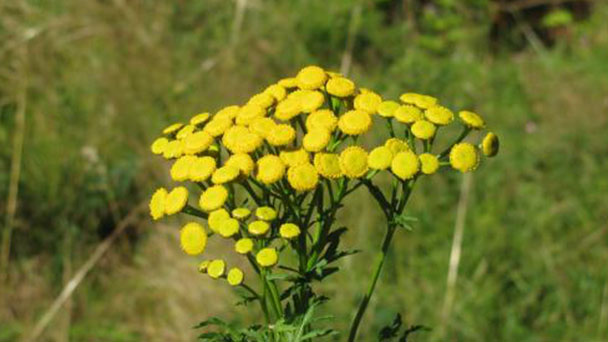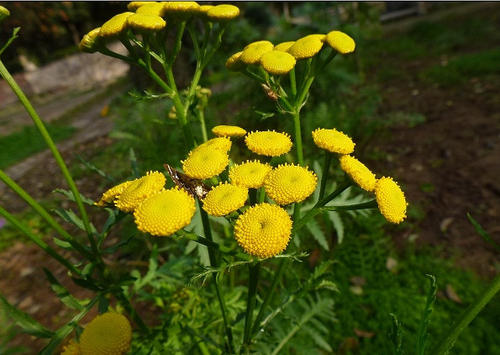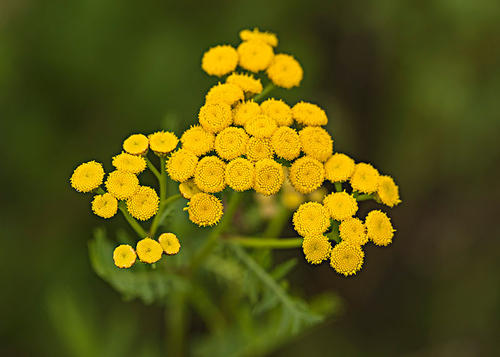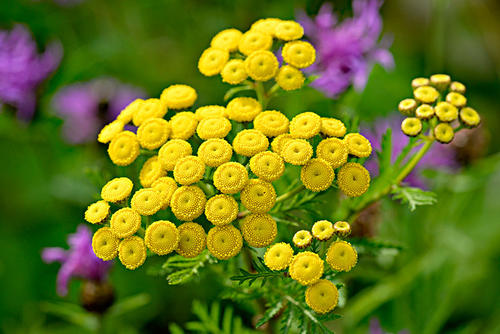Tansy (Tanacetum vulgare) profile
Written by Maggie
Mar 03 2021

Tansy, Latin name: Tanacetum Vulgare L.Compositae, also called Common Tansy, Golden Buttons, is a perennial herb.
Tansy picture

Tansy info
| Botanical Name | Tanacetum vulgare |
| Common Names | Common tansy, bitter buttons, cow bitter, golden buttons |
| Plant Type | Herbaceous perennial flowering plant |
| Mature Size | 2 to 4 feet tall, 12- to 18-inch spread |
| Natural Range | Europe and Asia |
| Bloom Description | Summer |
| Sun | Full sun to part shade |
| Toxicity | Yes |
| Flower | Yellow |
Morphological characteristics of tansy
Tansy is a perennial herb, 30-150 cm tall.Stems erect, solitary or few in clusters, branched only distally, with very sparse unilhairs, but usually glabrous. Stems and leaves are most, holomorphic elliptic or elliptical oval, up to 25 cm, two pinnate split. The primary lobe of tansy is completely cleft with 12 pairs of lateral lobes. The second lobe is deeply lobed, the second lobe is ovate, linear-lanceolate, obliquely triangular or oblong, the margin entire or shallow toothed or hemifid and divided into three pinnately divided leaves. Feather shaft pitted teeth. Lower stems and leaves of tansy have long stalk, middle and upper stems and leaves sessile. Leaves are all green or light green, very sparsely hairy or barely glabrous. Inflorescences of tansy are most (10-20) are arranged in dense corymbs or compound corymbs at the top of the stems and branches.Involucral bracts 5-13 mm in diameter. Involucral bracts are 3-layered, herbaceous. Outer layer of tansy is ovate-lanceolate, ca. 1.5 mm long, middle inner layer lanceolate or oblong, 3 -- 4 mm long. Bracts are with white or light brown margin narrowly membranous, apically membranous dilated. All florets of tansy are tubular, marginal female flowers smaller than bisexual ones. Achenes are 1.2-2 mm long. Coronal crown hairs are 0.1-0.4 mm long, crown margin shallowly toothed.
The ecological habits of tansy
Tansy was born on hillsides, river beaches, grassland, hilly and birch forests, 250-2400 meters above sea level.
Tansy's distribution area
Tansy distributes in Heilongjiang and Xinjiang (Altay, Tianshan). North America, Japan, Korea, Mongolia, Soviet Central Asia and Europe are also found.
How to grow and care for tansy
1. Fertilization care
Tansy has a high demand for fertilizer during the growing period, so light fertilizer can be applied several times during the growing period to accelerate the growth rate of Tansy.
2. Water care
Tansy is very afraid of waterlogging in the growing season, so water must not occur when watering. If it is in the rainy season, you can choose to water less or no watering, and in the high temperature season, you need to water many times, but can not grow in the high temperature and humidity environment for a long time.
3. Pruning care
Tansy is reasonable in the growing season to pick the heart in order to make it grow more branches, so as to achieve the effect of firecrackers, otherwise the number of flowers will not be very much.
4. Light
Tansy flowers grow best in full sun, though they can tolerate part shade.

5. Soil
Tansy prefers well-drained, fertile garden soil but tolerate almost any soil conditions.
6. Temperature and Humidity
Tansy flowers are hardy to minus-40 degrees Fahrenheit. It does not do well in extreme prolonged heat.
Tansy pests and diseases control
Unfortunately, there are few pests and diseases to keep common tansy from spreading rampantly. The principle problem is removing the plant when it is unwanted.
Recommended removal methods involve pulling out the plants with roots attached when soil is wet. Spot spraying with broad-spectrum herbicides can kill remaining plants. In pastures and meadows, planting competing native plants, combined with hand-pulling individual tansy plants, can gradually eliminate infestations.
Functions of tansy
Stems and heads of tansy contain insecticidal substances, which can be used as insecticides.
The whole grass contains tanacetin, tanansy A and tanacetol B. The volatile oil consists of lipoxygenone, viburnum alcohol in leaves and cislongipinane-2, 7-dione in flowers.
Tansy toxicity
Tansy is a poisonous plant included in the Chinese Plant Atlas Database, and its toxicity is that of whole grass. Tansy can cause poisoning by ingesting excessive amounts of Tansy oil and drinking leaves as tea. Livestock can also be poisoned by ingestion. Symptoms of human and animal poisoning are tremor, foaming at the mouth, intense spasm, pupil dilation, pulse frequency and weak, dyspnea, and death of heart paralysis finally.

Latest Updated
- Benefits of Bugleweed - 7 Science-backed Health Benefits
- Bugleweed Dangers & Side Effects - Is It Poisonous?
- How to Plant Evergreen Trees - What You Should Know
- When to Plant Evergreens - Grow Guide for Evergreen Trees
- 12 Wonderful Evergreen Shrubs for Your Garden
- 12 Popular Evergreen Plants with Pictures for Beginners
- When And How To Prune A Lilac Bush Like a Pro
- How to Grow & Care for Lilac Vine (Hardenbergia Violacea)
- Japanese Lilac Tree (Syringa Reticulata) Care & Propagation Guide
- Shumard Oak Pros and Cons - What to Know
Popular Articles
- Winter maintenance of Antirrhinum Majus
- How to Grow Terminalia Mantaly Tree
- How to Grow and Care for Crossostephium Chinense
- How to grow Antirrhinum Majus in spring
- Peristeria Elata (Dove Orchid) Profile: Info & Care Guide
- Underwatered Snake Plant (Sansevieria Trifasciata) - Signs And How To Fix
- How to Care for Brazilian Jasmine Plant (Mandevilla Sanderi)
- How to Grow & Care for Graptopetalum Purple Delight in Summer
- Rosa Chinensis (China Rose): Plant Growing & Care Tips
- How to Care for Baby Sun Rose (Aptenia Cordifolia)